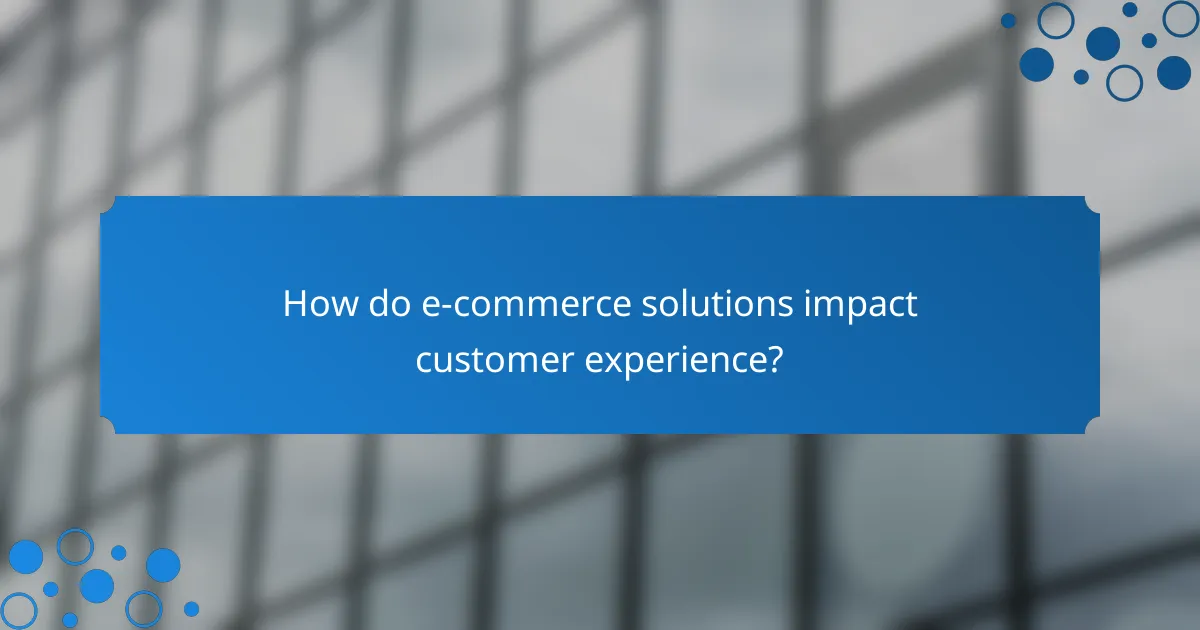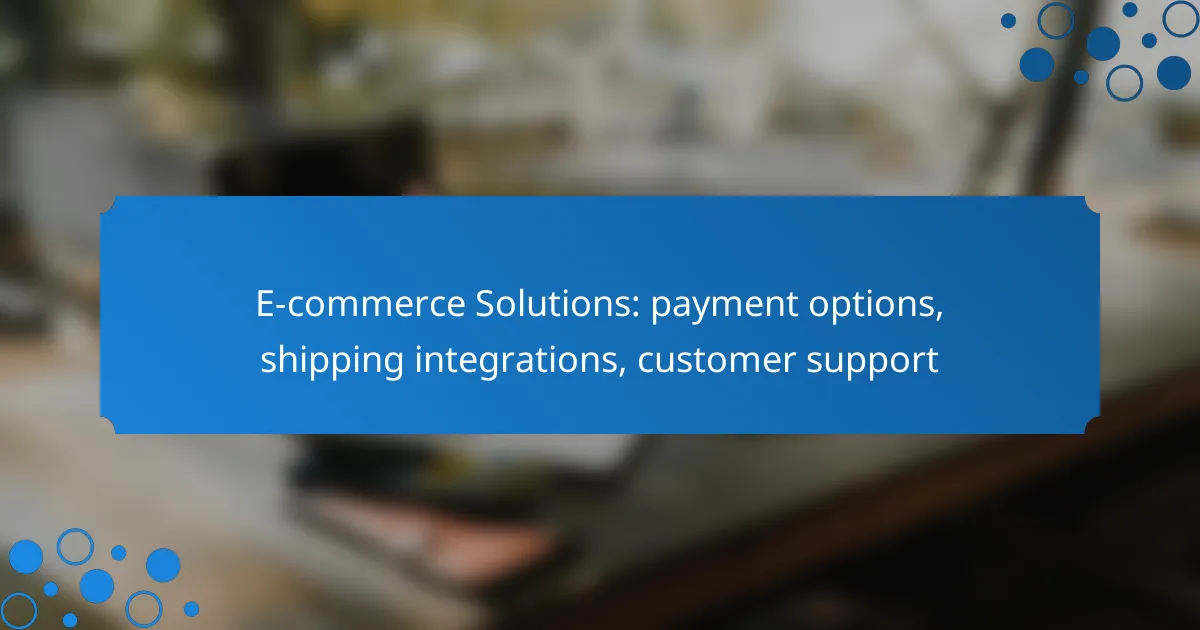In the competitive landscape of e-commerce, offering diverse payment options is crucial for catering to various customer preferences and enhancing the shopping experience. Additionally, integrating efficient shipping solutions can streamline order fulfillment, while robust customer support tools ensure effective communication and satisfaction. Together, these elements create a seamless online shopping environment that drives sales and fosters customer loyalty.

What are the best e-commerce payment options in Australia?
The best e-commerce payment options in Australia include a variety of platforms that cater to different business needs and customer preferences. Popular choices like PayPal, Stripe, Afterpay, Square, and Zip Pay offer unique features that can enhance the shopping experience and streamline transactions.
PayPal
PayPal is widely recognized for its ease of use and security, making it a preferred choice for many Australian e-commerce businesses. It allows customers to pay using their PayPal balance, linked bank accounts, or credit cards, providing flexibility in payment methods.
To integrate PayPal, businesses can use plugins for popular e-commerce platforms or set up a PayPal business account. Be aware of transaction fees, which typically range from 1.5% to 3% per transaction, depending on the volume of sales.
Stripe
Stripe is a powerful payment processing platform that supports a wide range of payment methods, including credit cards and digital wallets. It is particularly favored by tech-savvy businesses due to its customizable API and extensive documentation.
When using Stripe, businesses can expect a fee of around 1.75% for domestic transactions. Setting up Stripe is straightforward, and it integrates seamlessly with many e-commerce platforms, allowing for a smooth checkout experience.
Afterpay
Afterpay allows customers to buy now and pay later, splitting their purchases into four interest-free payments. This option is increasingly popular among Australian consumers, especially younger shoppers looking for flexible payment plans.
Merchants using Afterpay benefit from increased conversion rates and higher average order values. However, businesses should consider the fees, which can be around 4% per transaction, when deciding to offer this payment method.
Square
Square provides a comprehensive payment solution that includes point-of-sale systems and online payment processing. It is ideal for small to medium-sized businesses looking for an all-in-one solution.
With Square, businesses pay a flat fee of about 1.6% per transaction for online sales. The platform is user-friendly and offers additional features like inventory management and sales analytics, making it a versatile choice for e-commerce.
Zip Pay
Zip Pay is another buy now, pay later service that allows customers to make purchases and pay off the balance over time. It is particularly appealing for customers who prefer to manage their cash flow without incurring interest charges.
For businesses, integrating Zip Pay can lead to increased sales and customer loyalty. Fees for merchants typically range from 2% to 4% per transaction, so it’s essential to evaluate the cost against potential sales growth.

How to integrate shipping solutions for e-commerce?
Integrating shipping solutions for e-commerce involves selecting platforms that streamline order fulfillment and delivery processes. Effective integration can enhance customer satisfaction and reduce operational costs.
ShipStation
ShipStation is a popular shipping software that connects with various e-commerce platforms to automate shipping tasks. It allows businesses to manage orders, print shipping labels, and track shipments from a single dashboard.
When using ShipStation, consider its compatibility with your e-commerce platform and the shipping carriers you prefer. It supports multiple carriers, which can help you find the best rates and delivery options for your customers.
Easyship
Easyship offers a comprehensive shipping solution that provides real-time shipping rates, tax calculations, and customs documentation. This platform is especially beneficial for international shipping, helping businesses navigate complex regulations.
To get started with Easyship, integrate it with your online store and set up your shipping preferences. The platform’s user-friendly interface simplifies the process of managing shipments and provides valuable insights into shipping costs.
Australia Post integration
Integrating Australia Post into your e-commerce platform allows you to access a reliable shipping service within Australia. This integration enables you to offer various shipping options, including express and standard delivery.
When integrating Australia Post, ensure you configure your shipping settings to reflect accurate rates and delivery times. Utilizing their tracking features can enhance customer experience by providing updates on shipment status.
Sendle
Sendle is a cost-effective shipping solution tailored for small businesses in Australia. It provides door-to-door delivery services and is known for its flat-rate pricing, making it easier to manage shipping costs.
To integrate Sendle, connect it with your e-commerce platform and set up your account. Take advantage of their user-friendly tools to streamline your shipping process and improve delivery efficiency for your customers.

What customer support tools are effective for e-commerce?
Effective customer support tools for e-commerce streamline communication, enhance customer satisfaction, and improve overall service efficiency. Key options include platforms that offer ticketing systems, live chat, and multi-channel support to meet diverse customer needs.
Zendesk
Zendesk is a widely used customer support tool that provides a comprehensive ticketing system and multi-channel support, including email, chat, and social media. It allows businesses to manage customer inquiries efficiently and track interactions across different platforms.
One of its strengths is the robust reporting and analytics features, which help businesses identify trends and areas for improvement. Additionally, Zendesk integrates with various e-commerce platforms, making it easier to provide seamless support.
Freshdesk
Freshdesk offers a user-friendly interface and includes features such as ticketing, automation, and collaboration tools. It is particularly beneficial for small to medium-sized e-commerce businesses looking for an affordable solution with essential capabilities.
This platform supports multiple channels, allowing customers to reach out via email, phone, chat, and social media. Freshdesk also provides customizable templates and workflows, enabling businesses to tailor their support processes effectively.
LiveChat
LiveChat specializes in real-time communication, allowing e-commerce businesses to engage with customers instantly. This tool is ideal for addressing urgent inquiries and providing immediate assistance, which can significantly enhance customer satisfaction.
With features like chat transcripts, automated greetings, and integration with CRM systems, LiveChat helps streamline customer interactions. It is particularly effective for businesses that prioritize quick response times and personalized service.
Gorgias
Gorgias is designed specifically for e-commerce, integrating with platforms like Shopify and Magento to centralize customer support. It combines ticketing with automation features to help businesses respond to common queries quickly.
Gorgias allows agents to manage customer interactions from various channels in one place, including email, chat, and social media. Its focus on e-commerce means it includes features tailored to online retail, such as order tracking and refund processing, making it a valuable tool for online sellers.

What are the key criteria for choosing e-commerce solutions?
When selecting e-commerce solutions, prioritize scalability, integration capabilities, and cost-effectiveness. These criteria ensure that your platform can grow with your business, seamlessly connect with other tools, and remain financially viable.
Scalability
Scalability refers to the ability of an e-commerce solution to handle increased traffic and transactions as your business expands. A scalable platform can accommodate growth without compromising performance, which is crucial during peak seasons or promotional events.
Consider solutions that offer flexible pricing models based on usage or sales volume. This allows you to manage costs effectively while ensuring that your infrastructure can support higher demand.
Integration capabilities
Integration capabilities determine how well your e-commerce solution can connect with other software, such as payment processors, shipping services, and customer relationship management (CRM) systems. A well-integrated platform streamlines operations and enhances customer experience.
Look for solutions that support popular APIs and plugins, making it easy to add functionalities as needed. For example, integrating with a shipping provider can automate order fulfillment, reducing manual work and improving efficiency.
Cost-effectiveness
Cost-effectiveness evaluates the overall value of an e-commerce solution relative to its features and performance. It’s essential to balance upfront costs with ongoing expenses, such as transaction fees and maintenance.
When assessing cost, consider both direct and indirect expenses. For instance, a lower-priced solution may have higher transaction fees that could add up significantly. Aim for a solution that provides a clear breakdown of costs to avoid unexpected charges.

How do e-commerce solutions impact customer experience?
E-commerce solutions significantly enhance customer experience by providing seamless interactions throughout the shopping journey. Key elements such as payment options, shipping integrations, and customer support play crucial roles in ensuring satisfaction and loyalty.
Streamlined checkout process
A streamlined checkout process minimizes friction, allowing customers to complete their purchases quickly and efficiently. This can involve reducing the number of steps required to finalize a transaction and offering multiple payment methods, such as credit cards, digital wallets, and buy now, pay later options.
To implement a streamlined checkout, consider features like guest checkout, auto-fill for returning customers, and clear progress indicators. Research shows that a complicated checkout can lead to cart abandonment rates exceeding 70%, so simplifying this process is essential.
Additionally, ensure that your checkout is mobile-friendly, as a significant portion of online shopping occurs on smartphones. Test your checkout flow regularly to identify and fix any bottlenecks that could frustrate customers.
